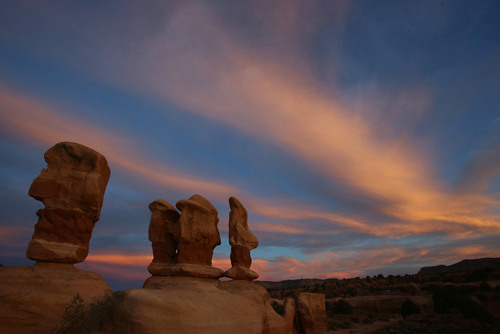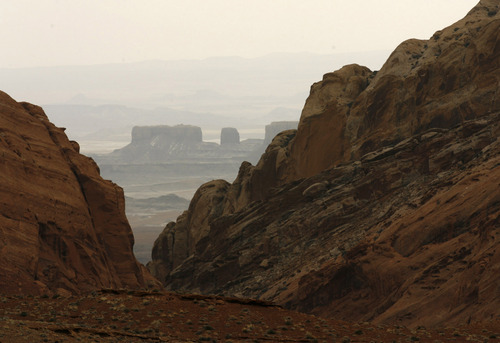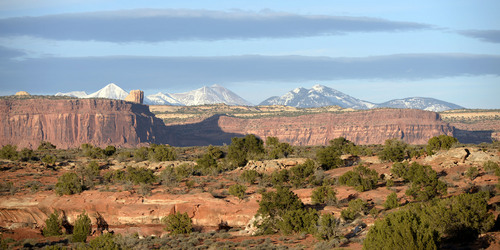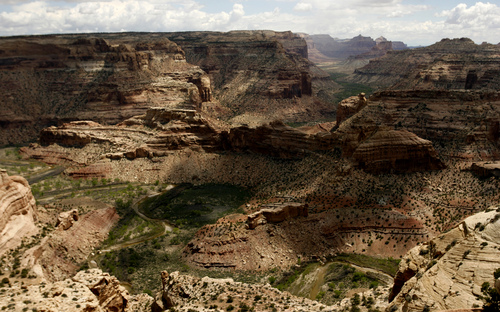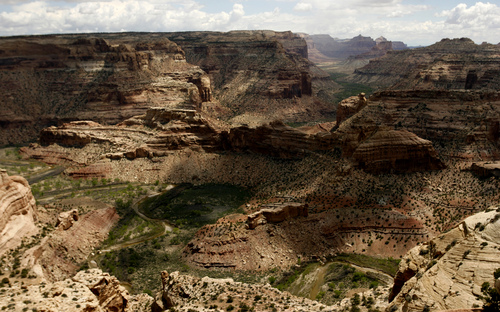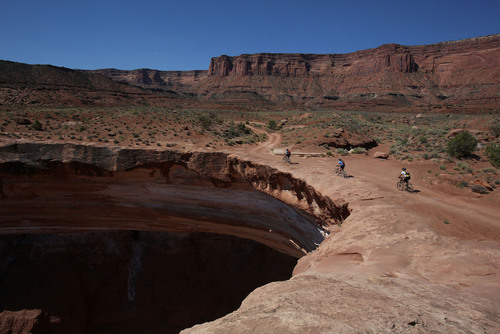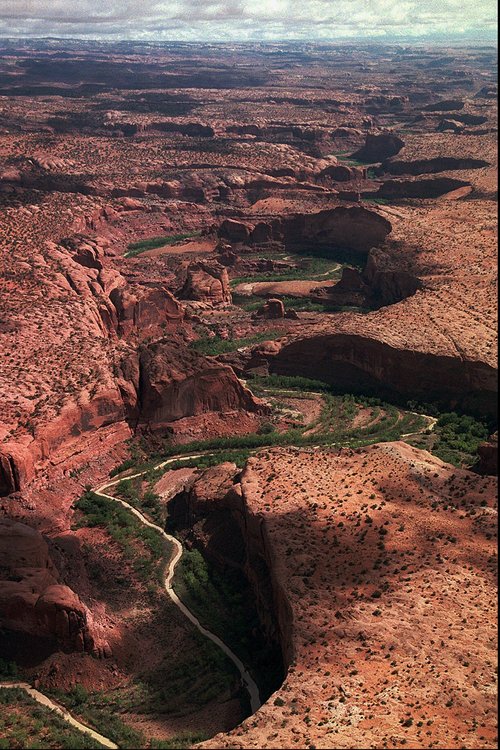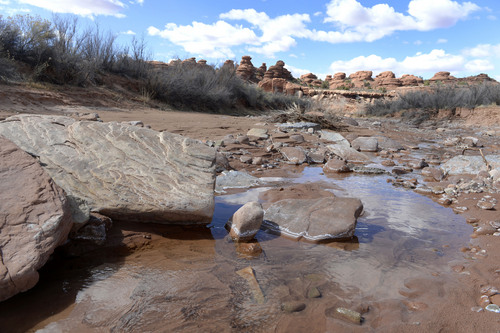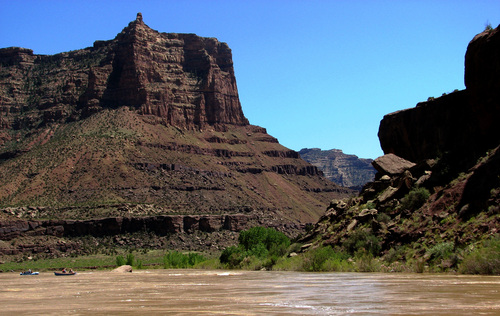This is an archived article that was published on sltrib.com in 2014, and information in the article may be outdated. It is provided only for personal research purposes and may not be reprinted.
Washington • Just south of Canyonlands National Park, the redrock wonders merge into a scrubland oasis with a peak that juts 11,000 feet into the sky. Mesas and buttes provide panoramic views and canyons, and ancient cliff dwellings offer a unique retreat.
It's a region that holds sacred and historic value to the Navajo Nation, which has pitched Congress on creating the Diné Bikéyah National Conservation Area to protect the 1.9 million acres in San Juan County from development. But as with most things involving Congress, inaction has been the order of the day.
Even as supporters of a conservation area remain hopeful, they're ready for Plan B: Asking President Barack Obama for a national monument.
Willie Grayeyes, and other members of the nonprofit Utah Diné Bikéyah, traveled recently to Washington to lobby Interior Department officials to designate the region north of the San Juan River and just outside the Navajo Reservation as a monument.
"The Utah delegates are only fumbling the ball. They aren't really tackling it," Grayeyes said. A monument is a logical fallback to congressional designation, under which many of the current uses could continue.
Obama already has named a handful of monuments across the country — using his unilateral power under the 1906 Antiquities Act — and has promised more.
"I'll use my authority to protect more of our pristine federal lands for future generations," he said in his State of the Union address earlier this year.
That commitment has some in the West fearing more intrusion by the federal government into their backyard, undermining locally driven efforts to decide the future of public lands. That fear isn't without precedent.
"It makes me worried that [the president will] just ignore the wishes of the people of Utah and just do what he wants to — like Clinton did," Sen. Orrin Hatch, R-Utah, said in a recent Salt Lake Tribune interview. "Sometimes he does act unilaterally."
Two months before his 1996 re-election, President Bill Clinton stood on the rim of the Grand Canyon in Arizona and declared 1.8 million acres of public land in Utah as the new Grand Staircase-Escalante National Monument. With a swipe of a pen, he canceled a proposed coal mine in what Hatch described then as the "mother of all land grabs."
"Like the attack on Pearl Harbor, this massive proclamation came completely without notice to the public," Hatch declared on the Senate floor. "The biggest presidential land set-aside in almost 20 years was a sneak attack."
Environmentalists hailed the action as long overdue to preserve these unique and pristine lands. Momentum may be accelerating for Obama to pull a similar move.
Since 2010, Congress has passed only one bill designating wilderness — 32,500 acres of sand dunes in Michigan — while others have stalled, even those with local support. That includes 13,000 acres proposed by Rep. Jim Matheson, D-Utah, to protect the Wasatch watershed.
In the absence of congressional action, environmentalists and some Democrats are urging Obama to go it alone.
—
The push • In January, 109 members of Congress — all Democrats — argued in a letter to the president that he has no choice but to use his power to name national monuments to protect treasured lands before they're gone. The 2010-2011 sessions of Congress had been the first in four decades not to set aside a single acre of wilderness, the members noted.
"Some initiatives require presidential leadership," they wrote, "and should not be bogged down by political infighting and paralysis, increasingly common characteristics of Congress."
Rep. Raul Grijalva of Arizona, the top Democrat on the public-lands subcommittee, says it's time for Obama to act, and if he named five or six monuments that had some local buy-in, he wouldn't face a backlash.
"I don't know if he'll do any now before the midterm [elections], but after that I think you'll see the preparations in earnest," Grijalva said in an interview.
Four of the five national parks in Utah started out as national monuments declared under the Antiquities Act, notes Jen Ujifusa, the legislative director of the Southern Utah Wilderness Alliance.
"History has shown that every time presidents protect the special places that we have in Utah, it's an economic boon for the state; it makes the state look good," Ujifusa said. "Posterity does smile on these designations, and we wouldn't have our mighty five national parks if we hadn't had forward-thinking presidents of both parties who recognized the beauty we have in Utah."
Republicans in Congress, though, are trying to tie any president's hands in making such declarations going forward. The House passed a bill by Rep. Rob Bishop, R-Utah, that would force any large monument designation to go through an environmental review and add a one-per-state-per-presidential-term limit. Several other measures — including one by Rep. Chris Stewart, R-Utah — would exempt states from the law, carve-outs that Alaska and Wyoming now enjoy.
"Teddy Roosevelt may have tried to save places, but, since [Jimmy] Carter, presidents have used this for political purposes not to try and preserve something," Bishop said. "We need to change that process."
Former Interior Secretary Ken Salazar warns that tinkering with this presidential power would be dangerous.
"What the House of Representatives did [in passing Bishop's bill] was wrongheaded," Salazar said recently, "and I think it would be opposed by any president, whether the president happens to be Republican or Democrat, because it's a significant intrusion into the long-standing authority with presidential powers that has been used effectively by Republicans and Democrats in office."
The Colorado Democrat, now in private practice, understands the frustration of folks who want Obama to set aside public lands and declare them off-limits to development.
"I think that would be great," he said. "I would urge [Interior Secretary Sally Jewell] and the president to do it."
There is no shortage of candidates.
—
Long list • In February 2010, Bishop unearthed a draft Interior Department memo that listed 14 potential new national monuments and the arguments for why the administration should preserve them. That included two in Utah: San Juan County's Cedar Mesa and Emery County's San Rafael Swell.
The memo cautioned that "further evaluations should be completed prior to any final decision, including an assessment of public and congressional support."
Backing was definitely absent as Salazar was called before Congress to explain. He said there was no "hidden federal agenda" and the memo was just a form of thinking out loud.
The list, though, contained many areas that observers on all sides agree could conceivably be singled out for monument designation: the two from Utah, as well as Greater Canyonlands, the San Gabriel Mountains in California, Boulder-White Clouds in Idaho, the Organ Mountains in New Mexico and Tule Springs in Nevada.
Bishop recently toured Tule Springs with local officials hoping for congressional action. Failing that, it could be on Obama's legacy list.
Jewell said recently that the administration is still focused on working with local officials on public-lands issues but that if Congress slow-plays, or sits on timely issues, there may come a time when the president has to step in.
She noted that some local areas actually lobby for a presidentially named monument because it brings more attention, tourism and economic development.
Still, she added, she supports Bishop's effort to bring parties together to solve regional public-land disputes.
"Sitting down at a table constructively, working together, understanding the local view is a very constructive path forward," she said.
Those words are nice to hear but don't make up for Obama's State of the Union comments.
San Juan County Commission Chairman Bruce Adams says designating the Diné Bikéyah area as a national monument against the community's wishes would be as controversial as the Grand Staircase announcement was in Garfield and Kane counties.
"It will not be received well," Adams said. "It will look like overreach on the part of the administration, more federal intrusion into the lives of the people who came here to pioneer a part of the country no one wanted."
Brian Maffly contributed to this story. —
Possible candidates for national monument status
Alpine Lakes – Washington
Berryessa Snow Mountain – California
Boulder-White Clouds – Idaho
Desolation Canyon – Eastern Utah
Diné Bikéyah – San Juan County, Utah
Gold Butte – Nevada
Greater Canyonlands — Southeastern Utah
Organ Mountains – New Mexico
Rocky Mountain Front – Montana
San Gabriels – California
San Rafael Swell – Emery County, Utah
Tule Springs – Nevada Live debate: Managing federal lands in Utah
I On May 14 at 7 p.m., The Tribune's Jennifer Napier-Pearce will moderate an Oxford-style debate between three Utahns in support of current federal lands policy and three in opposition.
Once the two sides have debated, the live audience will choose a winner.
The debate is free and open to the public at the Salt Lake City Main Library, 210 E. 400 South. KCPW 88.3/105.3 FM will broadcast it live, and it also will be streamed live at sltrib.com.



